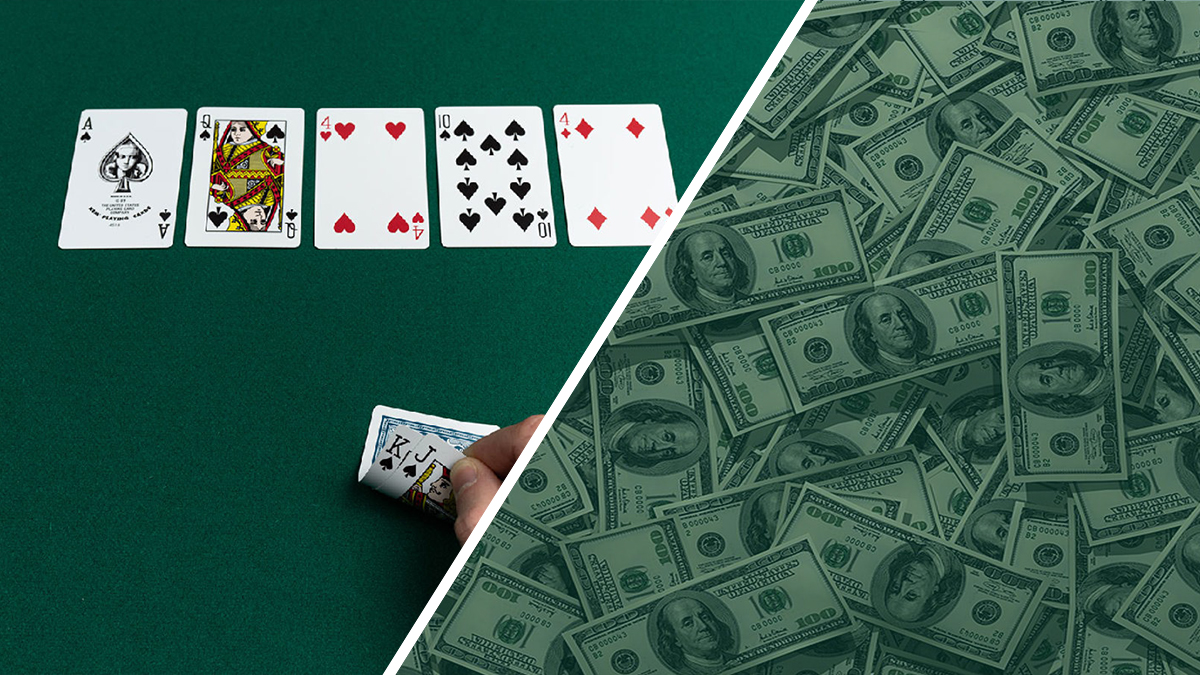I’ve been playing poker since I was a kid, but I didn’t learn to play Texas Hold’em until relatively late in life. It was probably 2005 or so before I started learning how to play. I even got started in online poker before I learned how to play Texas Hold’em. I was one of those nerds playing at the Seven-Card Stud tables instead.
Sooner or later, my group of friends began getting together online once a week to play. It didn’t take me long to learn the Texas Hold’em basics. But I didn’t start my journey toward becoming a reasonably competent player until I won a freeroll into a big tournament.
It had 6,000 players, and I placed fifth in the tournament overall. I don’t remember how much money I won, but I remember it was more money than I made in a month at my first job.
Here’s how I did so well in my first online Texas Hold’em tournament ever.
I Read a Book About Getting an Edge at Gambling
In 2005, I didn’t have any books about winning at poker. I just had a book on winning at gambling in general, and that was David Sklansky’s How to Make $100,000 a Year Gambling for a Living.
It’s not specifically about poker, but it has sections explaining which games you can win long-term and which ones you can’t. Poker, like blackjack, is one of those gambling activities where a skilled player can get a long-term edge.
This book had a section about strategic concepts in poker, and it was basically a primer on how to actually win at poker. It had general strategy advice, but it also had a section specifically about Texas Hold’em.
The Most Important Lesson I Learned About General Poker Strategy
The strategic concepts section covered the following topics:
- Tight play
- Pot size
- Pot odds
- Aggression
- Position
- Deception
- Psychology
- Upcards
- Game theory
- Reading hands
The most important idea in this section of the book, for me, was the concept of tight play. This focuses largely on starting hand selection. Sklansky points out that pro poker players always play fewer hands that recreational poker players, even if they’re good recreational poker players.
Pro players play FAR fewer hands than bad poker players. There’s more to winning at poker than just tight play, but he suggests that playing tight accounts for half your profits at the poker table.
He also explains that the larger the ante (or the blinds), the more hands you must play to remain profitable. Finally, he suggests that the better your opponents are, the more often you should fold.
I Ignored Most of the Other Concepts in the General Strategy Section
Honestly, I was so new to the game that the discussion of pot size and pot odds mostly went over my head. Also, I was determined to learn how to get better at Texas Hold’em. I did have some familiarity with basic strategic poker concepts because I was doing all right at the Seven-Card Stud games.
And I spent a little time reading the subsection about aggression. He suggests that pro poker players are almost always aggressive when they have a reasonably good hand. Letting other players play for free or for cheap gives them a chance to draw cards that might beat you without having to pay for them.
Your goal is to win the pot.
Whether you win the pot because you have a better hand or because your opponent folds is only marginally relevant. The idea behind betting and raising aggressively is to risk losing that bet in exchange for the potential reward of winning the pot.
Just calling other players’ bets is a losing tactic. Good players bet or fold most of the time. If you’re betting, you always have a chance of winning the pot without going to a showdown. Also, if you’re being selective about which hands you’re playing, you’ll often, or usually, have the better hand when you’re betting. Your opponents need to pay if they want to stay in the hand with you.
Everything I just said about betting applies equally to raising. Bad players who raise all the time are maniacs, but tight players who raise a lot are winners.
General Texas Hold’em Strategy Advice I Took to Heart
The biggest tips in the general Texas Hold’em strategy seem simple enough if you’ve played for a while, but for someone new to the game like I was, they were revelatory:
- Know what the nuts are.
- Recognize when you hold the nuts.
- Position matters.
- Don’t overplay suited hands.
- High cards are important.
The nuts are the cards that make the best possible hand given the cards on the board. If you don’t know what the nuts are, you can’t estimate how likely it is that someone has the nuts. Also, if you think you have the nuts when you don’t, it will cost you a lot of money.
Since you gain more information the later you act, you should play tighter in early position than in late position.
Suited hands are better than unsuited hands, but they’re often overrated. They need other qualities to make them playable, like connectedness or high card value.
Finally, if you have a couple of high cards, you have just as good a chance of hitting a pair as someone who has a couple of low cards. But your pair will beat their pair if you both hit the flop.
Starting Hand Categories in Texas Hold’em
The simplest method I’ve ever seen for categorizing starting hands in Texas Hold’em was in this book. They only used five categories:
- Big pairs
- Small and medium pairs
- High cards
- Suited connectors
- Big-little suited
According to their definitions, a big pair is any pair of 10s or higher. A big pair can win unimproved, and the bigger the pair, the more likely you are to win. A pair of aces is obviously better than a pair of 10s, but you should bet or raise preflop with any of these hands.
Small and medium pairs are much less valuable. To win with one of these hands, you’ll usually need to see it improve on the flop. The odds of that happening are only 8 to 1. These are drawing hands, so you need multiple players in the pot to make playing such a small or medium pair profitably.
High cards are hands that consist of two cards that are both 10 or higher. They’re stronger if they’re suited, but they still shouldn’t be overrated. Ace-king is the best hand in this category and should almost always be played aggressively, but a hand like K-10 offsuit is often a good idea to fold.
Suited connectors are hands that can make either a flush or a straight. If the hand has a gap, though, you’re less likely to make a straight. You should fold suited connectors if you’re in early position. You should only call a raise from late position if you have multiple players in the pot; you need to get paid off when you hit your hand to make staying in profitable.
Big-little suited is a hand with an ace or a king and another, lower-ranked card of the same suit. The authors suggest playing these hands like suited connectors, folding them in early position and not calling raises with them from late position unless you have multiple opponents.
Strategy on the Flop and Later
The authors suggest that any time you flop a drawing hand, like a flush draw or a straight draw, you should usually bet with this hand. You can win if everyone folds, and you can also win when you hit your hand.
Also, if your hand doesn’t improve on the flop, you should probably fold. Even good starting hands lose if the flop isn’t helpful.
If the flop is terrible, you’ll sometimes even need to fold big pairs. A pair of aces is great preflop. But if the flop comes up with the seven, eight, and nine of hearts, your opponents have all kinds of ways they might beat you. They could easily have a straight, a flush, or even three of a kind.
The authors suggest always folding with a small pair when you miss the flop.
Finally, if you flop a flush draw, it’s worthwhile to play the hand even if there’s a pair on the board. A lot of players fold in this situation, but you have 2 to 1 odds on making your flush, and you also have a chance of making a full house.
Conclusion
That’s about as basic an introduction to Texas Hold’em strategy as you could imagine, but it was enough for me to make it past a field of several thousand opponents and win a few thousand dollars in my first Texas Hold’em tournament.
Sure, luck had a lot to do with it, too. But I know I couldn’t have placed in that tournament without the strategies I learned from that book. And now, you know how you could potentially do the same.
Michael Stevens
Michael Stevens has been researching and writing topics involving the gambling industry for well over a decade now and is considered an expert on all things casino and sports betting. Michael has been writing for GamblingSites.org since early 2016. …



